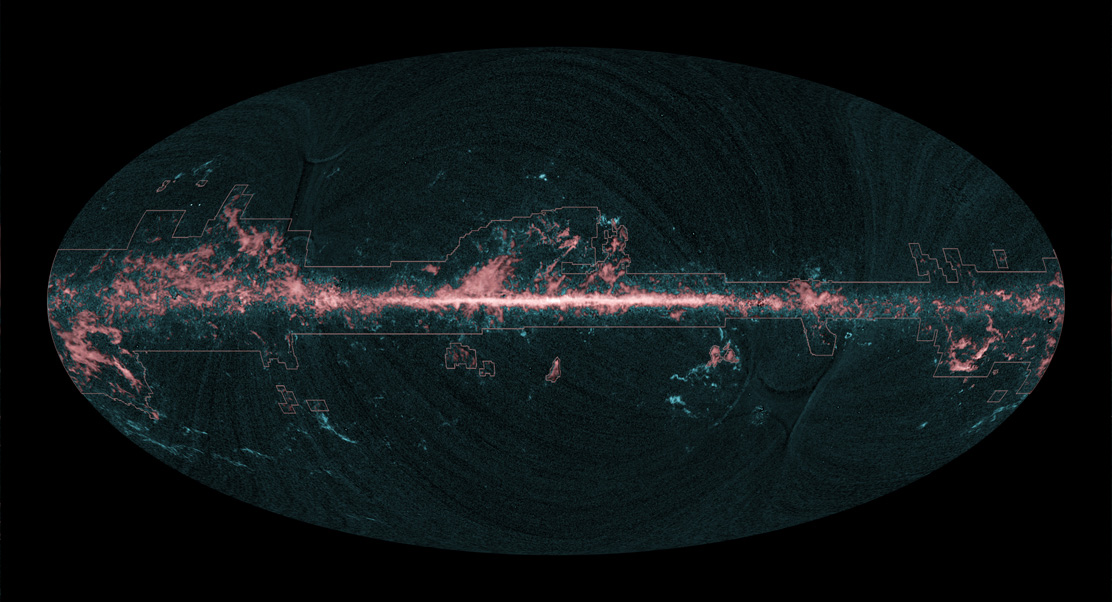The results include the first map of carbon monoxide to cover the entire sky. Carbon monoxide is a constituent of the cold clouds that populate the Milky Way and other galaxies. Predominantly made of hydrogen molecules, these clouds provide the reservoirs from which stars are born but hydrogen molecules are difficult to detect because they do not readily emit radiation. Carbon monoxide forms under similar conditions and, even though it is much rarer, it emits light more readily and therefore is more easily detectable. So, astronomers use it to trace the clouds of hydrogen.
Surveys of carbon monoxide undertaken with radio telescopes on the ground are extremely time consuming, hence they are limited to portions of the sky where molecular clouds are already known or expected to exist. ESA’s Planck mission has also detected a mysterious haze of microwaves that presently defies explanation. It comes from the region surrounding the galactic center and looks like a form of energy called synchrotron emission. This is produced when electrons pass through magnetic fields after having been accelerated by supernova explosions.

CLICK FOR LARGER SIZE. Molecular clouds, the dense and compact regions throughout the Milky Way where gas and dust clump together, represent one of the sources of foreground emission seen by Planck. The vast majority of gas in these clouds consists of molecular hydrogen (H2), and it is in these cold regions that stars are born. Since cold H2 does not easily radiate, astronomers trace these cosmic cribs across the sky by targeting other molecules, which are present there in very low abundance but radiate quite efficiently. The most important of these tracers is CO, which emits a number of rotational emission lines in the frequency range probed by Planck's High Frequency Instrument (HFI). Emission lines affect a very limited range of frequencies compared to the broad range to which each of Planck’s detectors is sensitive, and are usually observed using spectrometers. But some CO lines are so bright that they actually dominate the total amount of light collected by certain detectors on Planck when they are pointed towards a molecular cloud. Credits: ESA/Planck Collaboration
The curiosity is that the synchrotron emission associated with the galactic haze exhibits different characteristics from the synchrotron emission seen elsewhere in the Milky Way. The galactic haze shows what astronomers call a ‘harder’ spectrum: its emission does not decline as rapidly with increasing energies.
Several explanations have been proposed for this unusual behaviour, including higher supernova rates, galactic winds and even the annihilation of dark-matter particles. So far, none of them has been confirmed and it remains puzzling.
“The results achieved thus far by Planck on the galactic haze and on the carbon monoxide distribution provide us with a fresh view on some interesting processes taking place in our Galaxy,” says Jan Tauber, ESA’s Project Scientist for Planck.
Planck’s primary goal is to observe the Cosmic Microwave Background (CMB), the relic radiation from the Big Bang, and to measure its encoded information about the constituents of the Universe and the origin of cosmic structure. But it can only be reached once all sources of foreground emission, such as the galactic haze and the carbon monoxide signals, have been identified and removed.

This all-sky image shows the distribution of carbon monoxide (CO), a molecule used by astronomers to trace molecular clouds across the sky, as seen by Planck (blue). A compilation of previous surveys (Dame et al. (2001)), which left large areas of the sky unobserved, has been superimposed for comparison (red). The outlines identify the portions of the sky covered by these surveys. Credits: ESA/Planck Collaboration; T. Dame et al., 2001
“The lengthy and delicate task of foreground removal provides us with prime datasets that are shedding new light on hot topics in galactic and extragalactic astronomy alike,” says Tauber. “We look forward to characterising all foregrounds and then being able to reveal the CMB in unprecedented detail.”
Planck’s first cosmological dataset is expected to be released in 2013. These results were presented last week at an international conference in Bologna.





Comments